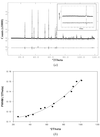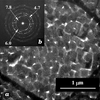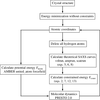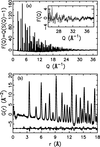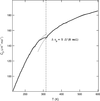issue contents
February 2004 issue

Cover illustration: Volumetric visualization of electron density surrounding a histidine residue, allowing for direct observation of discrete disorder; generated with POVScript+ and rendered with POVRay. Courtesy of T. D. Fenn, D. Ringe & G. A. Petsko [J. Appl. Cryst. (2003), 36, 944-947].
research papers
A framework for the detailed classification of general crystal structures, based on an arithmetic criterion, has been proposed in recent years. In this paper it is shown how this method can also be applied to enumerate colored crystals.
The accuracy of the weight fractions calculated with the Rietveld method from data collected using a rapid RTMS (real-time multiple strip) detector was verified. A fast, routine and accurate quantitative phase analysis for production control and quality management, meeting industrial requirements, can be obtained by combining the use of a rapid detector and user-friendly software.
The deterioration of GaInNAs/GaAs double-quantum-well structures is structurally analysed by various types of X-ray diffraction measurements. A clear picture explaining the sensitivity of the X-ray analysis to the deterioration process is presented, based on which a novel analysis procedure is proposed to improve the sensitivity.
The protein crystallography user facility at the neutron spallation source run by Los Alamos Neutron Science Center is described.
The application of the maximum-entropy method to the determination of particle size distributions by small-angle scattering is discussed. The maximum-entropy method is tested against the Fourier transform technique, and comparison between size distributions determined by small-angle scattering and transmission electron microscopy is made.
A method of determination of particle size distributions from small-angle scattering with polarized neutrons is described. The maximum-entropy method is applied together with simplex or simulated-annealing optimization techniques.
X-ray rocking-curve profiles for a perfect crystal are calculated using the mutual coherence function of the incident wave. This result allows experimental evaluation of the complex degree of coherence from measured rocking-curve profiles.
Dynamical theory for calculations of X-ray spectra from crystals modulated by surface acoustic waves
The dynamical theory, taking into account the real deformation of a crystal lattice, was used to model the X-ray diffraction spectra from a LiNbO3 crystal excited by surface acoustic waves.
A new type of fine-rotation stage, which can be attached to standard goniometers used in X-ray and neutron crystallography, has been constructed and tested.
Hen egg-white lysozyme (HEWL) crystals have been studied by means of double-crystal synchrotron topography. The crystals reveal a number of features that are quite well known in hydrothermally grown inorganic crystals: dislocations, growth bands and growth sector boundaries.
CATS is the Cryogenic Automated Transfer System for mounting/dismounting crystal samples. It has been installed on the FIP beamline at the European Synchrotron Radiation Facility (ESRF) and is dedicated to crystallography of biological macromolecules.
The lattice parameters of a `thin film' phase of pentacene [a = 6.1 (1), b = 7.6 (1), c = 15.3 (3) Å, α = 81.0 (16), β = 85.0 (17), γ = 89.5 (9)°] were determined using a series of diffraction patterns obtained by tilting the crystal in the electron microscope. This phase has a (001) d spacing of 15.1 (3) Å.
Download citation


Download citation


The lattice parameters of the cementite phase of Fe3C have been determined between 4 K and 600 K; the volumetric thermal expansion coefficient is greatly affected by the ferromagnetic to paramagnetic phase transition. The crystal structure varies only slightly, remaining orthorhombic (Pnma) throughout this temperature range.
The use of quantitative texture analysis and the recently developed combined method in the characterization by X-ray diffraction of polycrystalline ferroelectric thin films proved to be an important advance in the study of these materials. The results obtained, not available by conventional analysis, have produced important conclusions on the formation mechanisms that lead to textured films and on the correlation of these parameters with ferroelectric behaviour.
A fast procedure for non-destructive generation of three-dimensional grain maps is described based on the use of a wide beam of hard X-rays and an iterative algebraic algorithm.
A new effective algorithm to refine protein structure in solution from small-angle X-ray scattering data is developed based on restrained molecular dynamics.
A neutron powder diffraction atomic pair distribution function (PDF) round-robin experiment was performed on various diffractometers normally used for PDF studies. Effects of the instrument reciprocal-space resolution and probed reciprocal-space range on the real-space PDF are investigated and compared for these instruments.
Download citation


Download citation


The structure of CaTaOAlO4 (CTAO) has been determined using X-ray powder diffraction and density functional methods in combination with 27Al MAS NMR spectroscopy. A structural phase transition occurs near room temperature in CTAO as indicated by heat-capacity measurements, lattice strain data and infrared spectroscopy.
The effect of the variation of lattice parameters due to a single varying scalar variable (e.g. composition) on powder diffraction patterns was analysed. On this basis, a quantitative description of the observed anisotropic microstrain-like line broadening in X-ray powder diffraction patterns of a sample of hexagonal ∊-FeNy0 with average N content y0 = 0.433 was possible, yielding a standard deviation for y0 of 0.008.
Download citation


Download citation


A diffraction system has been constructed at the Synchrotron Radiation Centre at Ritsumeikan University, in which a wide-band parallel X-ray beam is produced by reflection from the depth-graded multilayer monochromator. In diffraction patterns of an oscillating single crystal recorded using the beam, Bragg reflections appear in an elongated form on an imaging-plate detector and, if the absorption edge of an atom in the crystal is included in the band, a characteristic intensity profile is seen due to anomalous dispersion.
A detailed phase diagram of lead magnesium niobate titanate has been constructed around the morphotropic phase boundary from measurements taken from one single crystal possessing a composition gradient. Optical birefringence imaging was employed as a function of temperature to plot retardation and orientation information as a function of temperature and position within the crystal, while electron-probe microanalysis measured the composition across the crystal and enabled the phase boundaries to be plotted to high precision.
Peculiarities of the diffraction patterns in short-periodic GaAlAs/GaAs superlattices were investigated in the case of quasi-forbidden reflections. The weak influence of GaAs layers on the diffraction pattern intensity, associated with a small value of an atomic form-factor difference as well as the appearance of periodic satellites, has been established.
short communications
Violations of the systematically absent reflections in a data set of stibnite in the space group Pnma have been shown to originate primarily from multiple diffraction.
A method is described to place a total of n copies of m different models in the asymmetric unit of a target crystal structure simultaneously and independently.
computer programs
Download citation


Download citation


The program TWINLAW reads two orientation matrices obtained from a non-merohedrally twinned crystal and evaluates the twin law. In a second step, the program HKLF5 uses this twin law to generate a reflection file for refinement with the HKLF5 option of the SHELXL program.
A modification of the well known DIFFaX code for the simulation of powder patterns allows the simultaneous refinement of the structure and microstructure of layered crystals. The new implementation is called DIFFaX+.
The mmLib toolkit is an open-source platform for the implementation of higher level programs to manipulate and visualize annotated structural models of biological macromolecules. It is written in Python and is dynamically extensible, so that applications built on top of mmLib benefit from this extensibility without requiring code revision or recompilation.
international union of crystallography
Free 



 journal menu
journal menu









